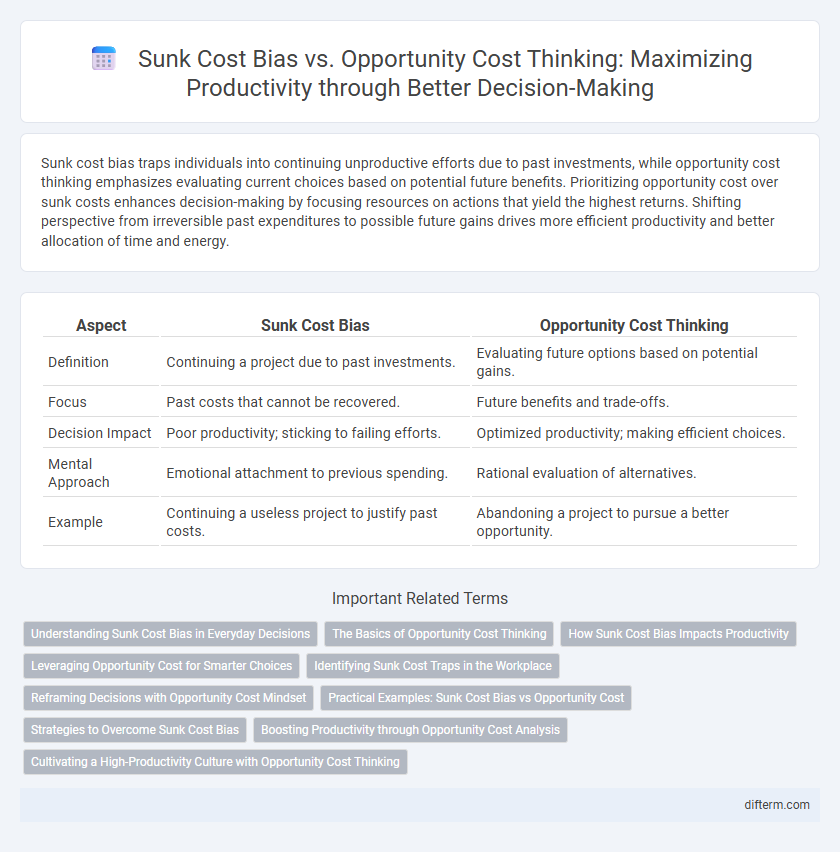Sunk cost bias traps individuals into continuing unproductive efforts due to past investments, while opportunity cost thinking emphasizes evaluating current choices based on potential future benefits. Prioritizing opportunity cost over sunk costs enhances decision-making by focusing resources on actions that yield the highest returns. Shifting perspective from irreversible past expenditures to possible future gains drives more efficient productivity and better allocation of time and energy.
Table of Comparison
| Aspect | Sunk Cost Bias | Opportunity Cost Thinking |
|---|---|---|
| Definition | Continuing a project due to past investments. | Evaluating future options based on potential gains. |
| Focus | Past costs that cannot be recovered. | Future benefits and trade-offs. |
| Decision Impact | Poor productivity; sticking to failing efforts. | Optimized productivity; making efficient choices. |
| Mental Approach | Emotional attachment to previous spending. | Rational evaluation of alternatives. |
| Example | Continuing a useless project to justify past costs. | Abandoning a project to pursue a better opportunity. |
Understanding Sunk Cost Bias in Everyday Decisions
Sunk cost bias often leads individuals to continue investing time or resources in unproductive tasks due to past commitments, negatively impacting overall productivity. Recognizing this bias helps in reallocating efforts toward opportunities with higher returns, enhancing decision-making efficiency. Emphasizing opportunity cost thinking encourages prioritizing future benefits over irrecoverable losses, driving more strategic and effective productivity choices.
The Basics of Opportunity Cost Thinking
Opportunity cost thinking involves evaluating the potential benefits lost when choosing one option over another, emphasizing future gains rather than past investments. This approach helps individuals prioritize actions that maximize productivity by focusing on current and future value rather than irrecoverable costs. Understanding opportunity costs encourages effective decision-making by highlighting trade-offs and promoting resource allocation toward the most beneficial outcomes.
How Sunk Cost Bias Impacts Productivity
Sunk cost bias reduces productivity by causing individuals to persist in unproductive tasks due to prior investments of time, money, or effort. This cognitive trap diverts attention from more beneficial opportunities, leading to inefficient allocation of resources and decreased overall output. Embracing opportunity cost thinking empowers better decision-making by prioritizing future gains over irrecoverable losses, thereby enhancing productivity.
Leveraging Opportunity Cost for Smarter Choices
Leveraging opportunity cost thinking boosts productivity by highlighting the value of alternatives foregone when making decisions, contrasting with the sunk cost bias that traps individuals in past investments. Prioritizing tasks and projects based on potential returns rather than irrecoverable past costs leads to smarter resource allocation and increased efficiency. This mindset shift enhances decision-making by focusing on future benefits and optimizing time management for maximum output.
Identifying Sunk Cost Traps in the Workplace
Sunk cost bias in the workplace leads employees and managers to continue investing time and resources into failing projects due to past commitments, ignoring the potential value of future opportunities. Recognizing sunk cost traps involves analyzing current project metrics objectively and prioritizing decisions based on expected future benefits rather than irrecoverable past investments. Incorporating opportunity cost thinking encourages shifting focus toward high-impact tasks and reallocating resources to initiatives with greater productivity returns.
Reframing Decisions with Opportunity Cost Mindset
Shifting from sunk cost bias to opportunity cost thinking enhances productivity by enabling clearer decision-making focused on future gains rather than past losses. This reframing encourages evaluating choices based on potential benefits, promoting more efficient use of time and resources. Embracing an opportunity cost mindset reduces persistence in unproductive tasks, driving progress toward higher-value outcomes.
Practical Examples: Sunk Cost Bias vs Opportunity Cost
Sunk cost bias often causes individuals to continue investing time or resources in failing projects, such as completing an unproductive course simply because they already paid for it. Opportunity cost thinking encourages evaluating potential benefits of alternative actions, like dropping the course to focus on a more promising skill development opportunity. Prioritizing decisions based on opportunity costs improves overall productivity by reallocating efforts to activities with higher returns.
Strategies to Overcome Sunk Cost Bias
To overcome sunk cost bias, focus on evaluating decisions based on future benefits rather than past investments, using opportunity cost thinking as a guide. Employ techniques like setting clear decision criteria, conducting regular project reviews, and embracing a cost-benefit analysis framework to prioritize options delivering the highest value. Adopting a mindset of flexibility and learning enables shifting resources away from unproductive commitments toward more promising and rewarding opportunities.
Boosting Productivity through Opportunity Cost Analysis
Sunk cost bias often traps individuals into continuing unproductive tasks due to past investments, while opportunity cost thinking shifts focus to potential gains from alternative actions. Prioritizing tasks through opportunity cost analysis enhances productivity by allocating time and resources to high-value activities. Embracing this mindset leads to better decision-making, maximizing output and reducing wasted effort.
Cultivating a High-Productivity Culture with Opportunity Cost Thinking
Cultivating a high-productivity culture requires shifting focus from sunk cost bias, which traps teams in past investments, to opportunity cost thinking that prioritizes future gains and efficient resource allocation. Organizations embracing opportunity cost analysis empower employees to make informed decisions that maximize output and drive innovation. This strategic mindset fosters continuous improvement and agile adaptation, essential for sustained productivity growth.
Sunk cost bias vs Opportunity cost thinking Infographic

 difterm.com
difterm.com